Aloe suprafoliata
Aloe suprafoliata Pole-Evans
Family: Asphodelaceae
Common names: book aloe, book-leaved aloe (Eng.), boekaalwyn (Afr.), icena, umhlabandlazi (isiZulu)
Introduction
Aloe suprafoliata has a distinctive growth habit that changes as it matures, with the young emerging leaves curving out sideways, stacked directly on top of each other like the pages of an open book, and only forming a rosette a few years later when mature. Flowers are bright pink to red in autumn and winter. The inflorescence is unbranched, but plants can produce multiple stalks from one rosette, each reaching about 1 m long.
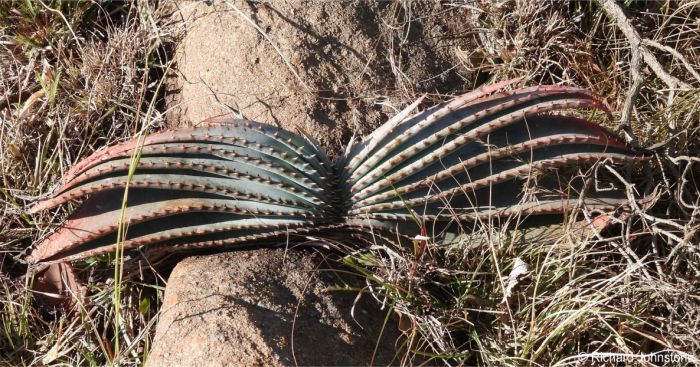
Description
Description
Aloe suprafoliata is an evergreen, frost hardy, stemless or short-stemmed aloe that grows up to 500-600 mm in height. It is unusual in that its growth habit changes as it ages. During the plant's juvenile phase, the leaves are stacked in two rows, one on top of the other and all in one plane (distichous leaf arrangement) but as the plant matures, the leaves spread out into the typical rosette shape. The succulent leaves can reach 400 mm long and 70 mm wide, with small thorny teeth along the margin, that are 2-5 mm long, sometimes forked, and spaced 5-10 mm apart. In less intense sunlight, the leaves are blue-green, but in bright conditions, they become milky blue-grey. During dry winter conditions, the rosette is often tinted reddish-brown on the outside. The inflorescence is simple (unbranched), the raceme, long and narrow, conical to cylindrical-acuminate, up to 250 mm long and 100 mm broad, sub-dense with a silvery sheen, with up to six inflorescences borne simultaneously on the plant. The flowers are rose-pink to scarlet-red, pencil-shaped (cylindrical), up to 50 mm long, buds pinkish-red tipped with slate grey or purplish-grey. The flowers buds are upward pointing, the open flowers point downards, and pivot as they mature to hold the seed capsules erect. Bracts lanceolate-acute, about 20 mm long. Pedicel is up to 20 mm long. Flowering time is in autumn and winter (May to July).
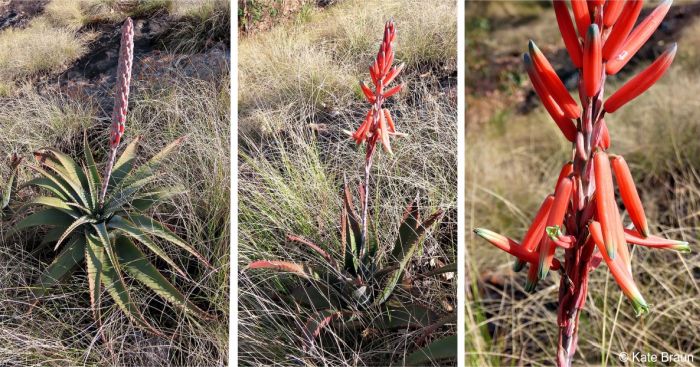
Aloe suprafoliata is the best-known example of an aloe transitioning from a fan-leaved juvenile to a rosette-leaved adult, it takes a few years to transition and frequently produces flowers while the leaves are still arranged in a distichous manner, an uncommon trait within the genus.
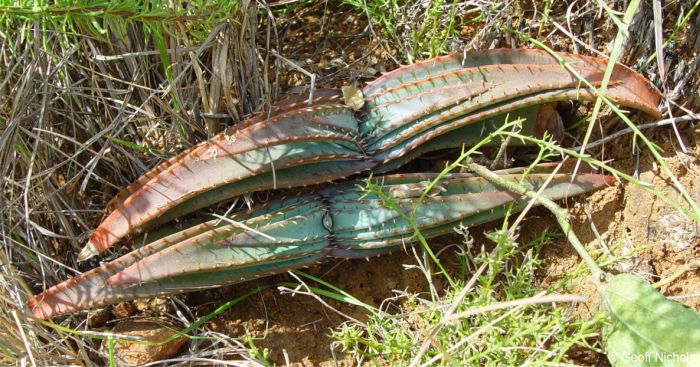
This Aloe species can be misidentified as Aloe pretoriensis when not in flower as they look similar, especially when young. When in flower it is easy to identify Aloe suprafoliata by its racemes which have a silvery sheen, rounded flower bracts, and simple inflorescence.
Conservation Status
Status
Aloe suprafoliata is distributed over a large area and is not under any threat or danger of becoming extinct, hence it’s assessed as Least Concern (LC) by the Red List of South African Plants.
Distribution and habitat
Distribution description
Aloe suprafoliata is endemic to southern Africa, it occurs in South Africa, Eswatini and Mozambique. Within South Africa it occurs in northern KwaZulu-Natal, where it grows in the mountains, and in eastern Mpumalanga in the Barberton area. This Aloe can be found growing in shallow soils on rocky slopes or in rock crevices on steep cliffs, in mountain grassland and open woodland.
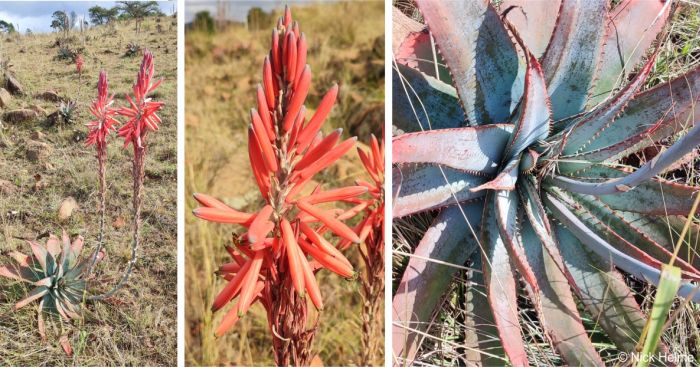
Derivation of name and historical aspects
History
The genus name Aloe is derived from the Greek word alloeh, meaning ‘bitter’ while the species name suprafoliata, meaning ‘with leaves on top’, refers to the leaves of juvenile plants being stacked one on top of the other all in one plane.
Ecology
Ecology
The flowers contain nectar that attracts bees and other insects as well as a variety of bird species.
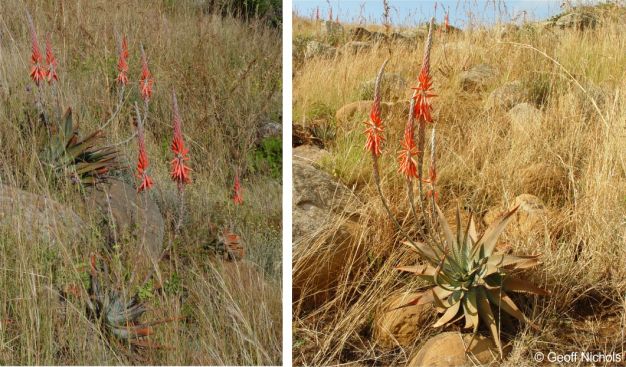
Uses
Use
There are no known medicinal uses for the book aloe but it is a rewarding ornamental plant that can be used in water-wise gardens, rocky gravel bed landscapes or as a filler plant on slopes, banks, cliffs, dry stack walls and in narrow spaces, and as a container plant.
Growing Aloe suprafoliata
Grow
Aloe suprafoliata is easily propagatedby seeds or suckers.
Sow seeds in trays filled with a mixture of coarse river sand, compost and soil. Spread the seeds evenly over the surface and lightly cover with a layer of small pebbles, this helps keep the seedlings upright and lessens the risk of damping off. Fresh seeds germinate quickly at 18°C. Place the seed tray in a dry well-ventilated area, keep the soil moist, do not allow it to dry out, but also do not let it get too wet as the seedlings may damp off if overwatered. The seedlings can be transplanted after one year.
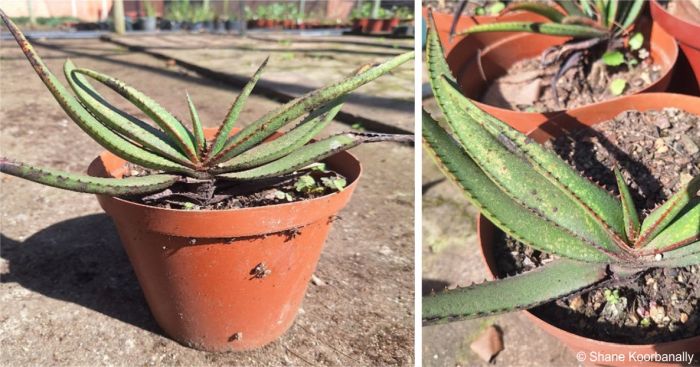
Offshoots around the main rosette can be divided and cuttings should be dried for a week before planting in river sand or well-drained potting soil and kept warm.
In containers, Aloe suprafoliata plants are generally slow-growing and don't require frequent repotting. Plants that are toppling over in their pots or are exhibiting a lack of growth, should be repotted . A fast-draining potting mix with one-third sand or pebbles is recommended. When dealing with larger plants, it is important to carefully separate the root ball. In cases where certain varieties produce offsets, it is advisable to pot them individually.
Aloe suprafoliata should be fertilized with a low-nitrogen fertilizer formulated for cacti and succulents, diluted to half the recommended strength, once or twice during the growing season.
In the garden, this plant thrives in sunny locations, in well-drained soil, with minimal water. It is well-suited for outdoor cultivation in mild climates for landscaping purposes and can also be grown in rocky, well-drained soil in drier regions. It adapts to various soil types (as long as the soil is well-drained) and climates, but flourishes in temperate regions that are not excessively cold or wet. The plant will also thrive in partial shade but will be healthier and flower better in full sun.
Aloe suprafoliata is highly drought-resistant, but for a healthy, floriferous plant, it should be watered moderately to generously in summer, but be careful not to overdo it. During the cold winter months, it is best to refrain from watering altogether. To maintain the plump appearance of the leaves, it is advisable to provide supplemental watering in summer if the rainfall is insufficient. Although it can withstand long periods of drought outdoors, it will thrive and produce more flowers if watered in spring and summer. On the other hand if watered only occasionally, then the the red colouration of the leaves will intensify.
Aloe suprafoliata will tolerate light frost but is susceptible to damage in hard freezes. Also, cool winter temperatures (around 5-10°C) will encourage flower development.
As with all succulents, avoid letting Aloe suprafoliata sit in stagnant water and refrain from overwatering, ensuring no water collects in the rosettes.
Incorrect watering, poor drainage, or too much shade can lead to rotting and infestations of pests and other diseases.
References
- Braun, K. 2024-May. Observation of Aloe suprafoliata, Ukuthula, Eswatini. iNaturalist. Online. https://www.inaturalist.org/observations/219058638.
- GBIF. Aloe suprafoliata Pole-Evans search. GBIF Backbone Taxonomy. Checklist dataset https://doi.org/10.15468/39omei. Accessed on 2024-08-20.
- Glen, H.F. & Hardy, D.S. 2000. Aloaceae (First part): Aloe. In: G. Germishuizen (ed.), Flora of Southern Africa, Vol. 5, Part 1, Fasc. 1: 1–159. National Botanical Institute, Pretoria.
- Helme, N. 2024-Jun. Observation of Aloe suprafoliata, Zululand, KZN. iNaturalist. Online. https://www.inaturalist.org/observations/227822467.
- Johnstone, R. 2024-Jun. Observation of Aloe suprafoliata, Louwsburg, KZN. iNaturalist. Online. https://www.inaturalist.org/observations/225717365.
- LLifle, The Encyclopedia of Succulents. Aloe suprafoliata Pole-Evans. http://www.llifle.com/Encyclopedia/SUCCULENTS/Family/Aloaceae/15240/ Aloe suprafoliata. Accessed on 16 August 2024.
- Mtshali, H. & Von Staden, L. 2018. Aloe suprafoliata Pole-Evans. National Assessment: Red List of South African Plants. Accessed on 2024/08/31.
- Reynolds, G.W. 1982. The Aloes of South Africa. A.A.Balkema, Cape Town.
- The Plant Library. Aloe suprafoliata. https://www.theplantlibrary.co.za/plants/aloe-suprafoliata. Accessed on 16 August 2024.
- Van Wyk, B. & Smith, G.F. 1996. Guide to the aloes of South Africa. Briza Publications, Pretoria.
- Wentzel, J. n.d. Aloe suprafoliata. Wildflower Nursery. Online. https://wildflowernursery.co.za/indigenous-plant-database/aloe-suprafoliata/. Accessed on 16 August 2024.
Credits
Keitumetse Lenong and Shane Koorbanally
KwaZulu-Natal National Botanical Garden
September 2024
Acknowledgements: images of plants in habitat by Geoff Nichols, and by Kate Braun, Nick Helme and Richard Johstone from their observations posted on iNaturalist.
Plant Attributes:
Plant Type: Succulent
SA Distribution: KwaZulu-Natal, Mpumalanga
Soil type: Sandy, Loam
Flowering season: Autumn, Winter
PH: Acid, Neutral
Flower colour: Red, Pink
Aspect: Full Sun
Gardening skill: Easy
Special Features:
Horticultural zones








Rate this article
Article well written and informative
Rate this plant
Is this an interesting plant?
Login to add your Comment
Back to topNot registered yet? Click here to register.